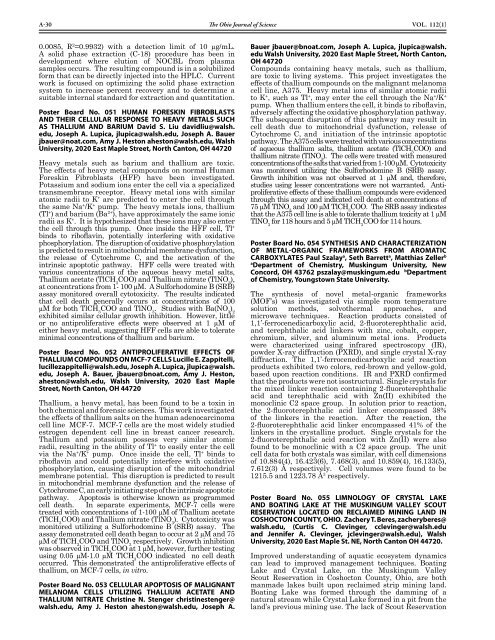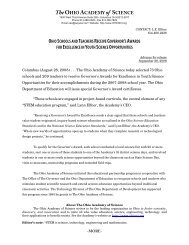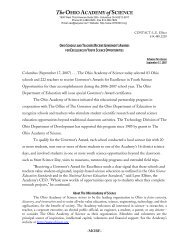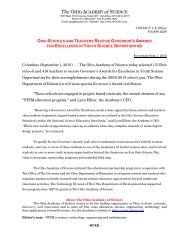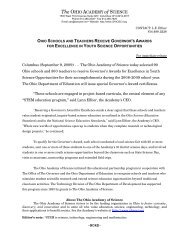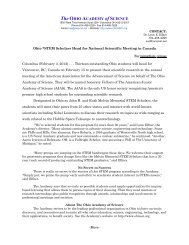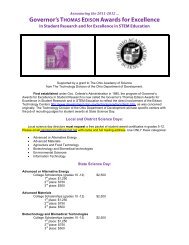The Ohio Journal of - The Ohio Academy of Science
The Ohio Journal of - The Ohio Academy of Science
The Ohio Journal of - The Ohio Academy of Science
Create successful ePaper yourself
Turn your PDF publications into a flip-book with our unique Google optimized e-Paper software.
A-30 <strong>The</strong> <strong>Ohio</strong> <strong>Journal</strong> <strong>of</strong> <strong>Science</strong><br />
Vol. 112(1)<br />
0.0085, R 2 =0.9932) with a detection limit <strong>of</strong> 10 µg/mL.<br />
A solid phase extraction (C-18) procedure has been in<br />
development where elution <strong>of</strong> NOCBL from plasma<br />
samples occurs. <strong>The</strong> resulting compound is in a solubilized<br />
form that can be directly injected into the HPLC. Current<br />
work is focused on optimizing the solid phase extraction<br />
system to increase percent recovery and to determine a<br />
suitable internal standard for extraction and quantitation.<br />
Poster Board No. 051 HUMAN FORESKIN FIBROBLASTS<br />
AND THEIR CELLULAR RESPONSE TO HEAVY METALS SUCH<br />
AS THALLIUM AND BARIUM David S. Liu davidliu@walsh.<br />
edu, Joseph A. Lupica, jlupica@walsh.edu, Joseph A. Bauer<br />
jbauer@noat.com, Amy J. Heston aheston@walsh.edu, Walsh<br />
University, 2020 East Maple Street, North Canton, OH 44720<br />
Heavy metals such as barium and thallium are toxic.<br />
<strong>The</strong> effects <strong>of</strong> heavy metal compounds on normal Human<br />
Foreskin Fibroblasts (HFF) have been investigated.<br />
Potassium and sodium ions enter the cell via a specialized<br />
transmembrane receptor. Heavy metal ions with similar<br />
atomic radii to K + are predicted to enter the cell through<br />
the same Na + /K + pump. <strong>The</strong> heavy metals ions, thallium<br />
(Tl + ) and barium (Ba 2+ ), have approximately the same ionic<br />
radii as K + . It is hypothesized that these ions may also enter<br />
the cell through this pump. Once inside the HFF cell, Tl +<br />
binds to rib<strong>of</strong>lavin, potentially interfering with oxidative<br />
phosphorylation. <strong>The</strong> disruption <strong>of</strong> oxidative phosphorylation<br />
is predicted to result in mitochondrial membrane dysfunction,<br />
the release <strong>of</strong> Cytochrome C, and the activation <strong>of</strong> the<br />
intrinsic apoptotic pathway. HFF cells were treated with<br />
various concentrations <strong>of</strong> the aqueous heavy metal salts,<br />
Thallium acetate (TlCH 3 COO) and Thallium nitrate (TlNO 3 ),<br />
at concentrations from 1- 100 µM. A Sulforhodomine B (SRB)<br />
assay monitored overall cytotoxicity. <strong>The</strong> results indicated<br />
that cell death generally occurs at concentrations <strong>of</strong> 100<br />
µM for both TlCH 3 COO and TlNO 3 . Studies with Ba(NO 3 ) 2<br />
exhibited similar cellular growth inhibition. However, little<br />
or no antiproliferative effects were observed at 1 µM <strong>of</strong><br />
either heavy metal, suggesting HFF cells are able to tolerate<br />
minimal concentrations <strong>of</strong> thallium and barium.<br />
Poster Board No. 052 ANTIPROLIFERATIVE EFFECTS OF<br />
THALLIUM COMPOUNDS ON MCF-7 CELLS Lucille E. zappitelli,<br />
lucillezappitelli@walsh.edu, Joseph A. Lupica, jlupica@walsh.<br />
edu, Joseph A. Bauer, jbauer@bnoat.com, Amy J. Heston,<br />
aheston@walsh.edu, Walsh University, 2020 East Maple<br />
Street, North Canton, OH 44720<br />
Thallium, a heavy metal, has been found to be a toxin in<br />
both chemical and forensic sciences. This work investigated<br />
the effects <strong>of</strong> thallium salts on the human adenocarcinoma<br />
cell line MCF-7. MCF-7 cells are the most widely studied<br />
estrogen dependent cell line in breast cancer research.<br />
Thallium and potassium possess very similar atomic<br />
radii, resulting in the ability <strong>of</strong> Tl + to easily enter the cell<br />
via the Na + /K + pump. Once inside the cell, Tl + binds to<br />
rib<strong>of</strong>lavin and could potentially interfere with oxidative<br />
phosphorylation, causing disruption <strong>of</strong> the mitochondrial<br />
membrane potential. This disruption is predicted to result<br />
in mitochondrial membrane dysfunction and the release <strong>of</strong><br />
Cytochrome C, an early initiating step <strong>of</strong> the intrinsic apoptotic<br />
pathway. Apoptosis is otherwise known as programmed<br />
cell death. In separate experiments, MCF-7 cells were<br />
treated with concentrations <strong>of</strong> 1-100 µM <strong>of</strong> Thallium acetate<br />
(TlCH 3 COO) and Thallium nitrate (TlNO 3 ). Cytotoxicity was<br />
monitored utilizing a Sulforhodomine B (SRB) assay. <strong>The</strong><br />
assay demonstrated cell death began to occur at 2 µM and 75<br />
µM <strong>of</strong> TlCH 3 COO and TlNO 3 respectively. Growth inhibition<br />
was observed in TlCH 3 COO at 1 µM, however, further testing<br />
using 0.05 µM-1.0 µM TlCH 3 COO indicated no cell death<br />
occurred. This demonstrated the antiproliferative effects <strong>of</strong><br />
thallium, on MCF-7 cells, in vitro.<br />
Poster Board No. 053 CELLULAR APOPTOSIS OF MALIGNANT<br />
MELANOMA CELLS UTILIzING THALLIUM ACETATE AND<br />
THALLIUM NITRATE Christine N. Stenger christinestenger@<br />
walsh.edu, Amy J. Heston aheston@walsh.edu, Joseph A.<br />
Bauer jbauer@bnoat.com, Joseph A. Lupica, jlupica@walsh.<br />
edu Walsh University, 2020 East Maple Street, North Canton,<br />
OH 44720<br />
Compounds containing heavy metals, such as thallium,<br />
are toxic to living systems. This project investigates the<br />
effects <strong>of</strong> thallium compounds on the malignant melanoma<br />
cell line, A375. Heavy metal ions <strong>of</strong> similar atomic radii<br />
to K + , such as Tl + , may enter the cell through the Na + /K +<br />
pump. When thallium enters the cell, it binds to rib<strong>of</strong>lavin,<br />
adversely affecting the oxidative phosphorylation pathway.<br />
<strong>The</strong> subsequent disruption <strong>of</strong> this pathway may result in<br />
cell death due to mitochondrial dysfunction, release <strong>of</strong><br />
Cytochrome C, and initiation <strong>of</strong> the intrinsic apoptotic<br />
pathway. <strong>The</strong> A375 cells were treated with various concentrations<br />
<strong>of</strong> aqueous thallium salts, thallium acetate (TlCH 3 COO) and<br />
thallium nitrate (TlNO 3 ). <strong>The</strong> cells were treated with measured<br />
concentrations <strong>of</strong> the salts that varied from 1-100 µM. Cytotoxicity<br />
was monitored utilizing the Sulforhodomine B (SRB) assay.<br />
Growth inhibition was not observed at 1 µM and, therefore,<br />
studies using lesser concentrations were not warranted. Antiproliferative<br />
effects <strong>of</strong> these thallium compounds were evidenced<br />
through this assay and indicated cell death at concentrations <strong>of</strong><br />
75 µM TlNO 3 and 100 µM TlCH 3 COO. <strong>The</strong> SRB assay indicates<br />
that the A375 cell line is able to tolerate thallium toxicity at 1 µM<br />
TlNO 3 for 118 hours and 5 µM TlCH 3 COO for 114 hours.<br />
Poster Board No. 054 SYNTHESIS AND CHARACTERIzATION<br />
OF METAL-ORGANIC FRAMEWORKS FROM AROMATIC<br />
CARBOXYLATES Paul Szalay a , Seth Barrett a , Matthias zeller b<br />
a Department <strong>of</strong> Chemistry, Muskingum University, New<br />
Concord, OH 43762 pszalay@muskingum.edu b Department<br />
<strong>of</strong> Chemistry, Youngstown State University.<br />
<strong>The</strong> synthesis <strong>of</strong> novel metal-organic frameworks<br />
(MOF’s) was investigated via simple room temperature<br />
solution methods, solvothermal approaches, and<br />
microwave techniques. Reaction products consisted <strong>of</strong><br />
1,1’-ferrocenedicarboxylic acid, 2-fluoroterephthalic acid,<br />
and terephthalic acid linkers with zinc, cobalt, copper,<br />
chromium, silver, and aluminum metal ions. Products<br />
were characterized using infrared spectroscopy (IR),<br />
powder X-ray diffraction (PXRD), and single crystal X-ray<br />
diffraction. <strong>The</strong> 1,1’-ferrocenedicarboxylic acid reaction<br />
products exhibited two colors, red-brown and yellow-gold,<br />
based upon reaction conditions. IR and PXRD confirmed<br />
that the products were not isostructural. Single crystals for<br />
the mixed linker reaction containing 2-fluoroterephthalic<br />
acid and terephthalic acid with Zn(II) exhibited the<br />
monoclinic C2 space group. In solution prior to reaction,<br />
the 2-fluoroterephthalic acid linker encompassed 38%<br />
<strong>of</strong> the linkers in the reaction. After the reaction, the<br />
2-fluoroterephthalic acid linker encompassed 41% <strong>of</strong> the<br />
linkers in the crystalline product. Single crystals for the<br />
2-fluoroterephthalic acid reaction with Zn(II) were also<br />
found to be monoclinic with a C2 space group. <strong>The</strong> unit<br />
cell data for both crystals was similar, with cell dimensions<br />
<strong>of</strong> 10.884(4), 16.423(6), 7.468(3), and 10.859(4), 16.133(5),<br />
7.612(3) Å respectively. Cell volumes were found to be<br />
1215.5 and 1223.78 Å 3 respectively.<br />
Poster Board No. 055 LIMNOLOGY OF CRYSTAL LAKE<br />
AND BOATING LAKE AT THE MUSKINGUM VALLEY SCOUT<br />
RESERVATION LOCATED ON RECLAIMED MINING LAND IN<br />
COSHOCTON COUNTY, OHIO. zachery T. Beres, zacheryberes@<br />
walsh.edu, (Curtis C. Clevinger, cclevinger@walsh.edu<br />
and Jennifer A. Clevinger, jclevinger@walsh.edu), Walsh<br />
University, 2020 East Maple St. NE, North Canton OH 44720.<br />
Improved understanding <strong>of</strong> aquatic ecosystem dynamics<br />
can lead to improved management techniques. Boating<br />
Lake and Crystal Lake, on the Muskingum Valley<br />
Scout Reservation in Coshocton County, <strong>Ohio</strong>, are both<br />
manmade lakes built upon reclaimed strip mining land.<br />
Boating Lake was formed through the damming <strong>of</strong> a<br />
natural stream while Crystal Lake formed in a pit from the<br />
land’s previous mining use. <strong>The</strong> lack <strong>of</strong> Scout Reservation


